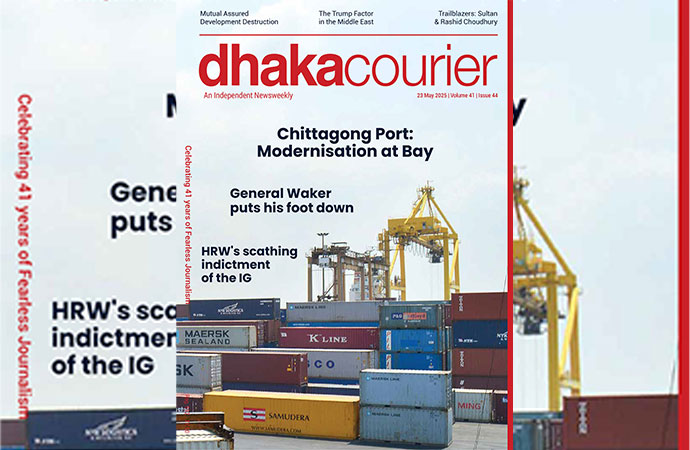Society

The statue of Dutch engineer Cornelis van Doorn.
How it is returning to former glory as an agro-products center
A quick search for Fukushima on any internet search engine invariably leads to the March 2011 tsunami-induced meltdown at the Tokyo Electric Power Company's nuclear power plant. It firmly placed the name of Japan's once sleepy hinterland into the red list of localities that gain infamy almost overnight. This blanket assumption is definitely not doing justice to Fukushima and hurting the prefecture's economy hard.
More than seven years after the ill luck had stricken the region, Fukushima is now slowly returning to its earlier fame as a premier rice growing region of the country. But the journey was not an easy one and it is the determination of people involved in agriculture and farming that contributed significantly in forging the path to recovery.
Fukushima is the third-largest of Japan's 47 prefectures and its territorial border stretches nearly 100 miles from the Pacific Ocean through the ancient mountains in the north-eastern part of Japan's main Honshu Island. This important farming stronghold had been supplying rice, vegetables, meat and fish not only to Japanese consumers, but also to overseas markets. However, this came to an abrupt end right after the nuclear disaster due to the spread of radiation fear. Though the radiation fallout did not affect every region of the prefecture, the reaction had been a blanket one, affecting the products of the whole region.
In fiscal year 2010, which ended in the month of March the following calendar year, Fukushima exported 153 tons of agricultural products. However, the export fell to almost zero after the disaster. Thanks to a prolonged sales promotion effort and campaign for regaining public confidence, Fukushima's agriculture had since then been able to fight back the adversity and prefecture's agro-product export in 2017 fiscal year amounted 210 tons, the largest volume since Fukushima began compiling such statistics in 2005. This remarkable comeback was made possible by the relentless efforts of all the actors, ranging from farming groups to local leadership and with the active support of the central government.
Fukushima's road to development and modernity is closely connected with Japan's modernization that started with the Meiji Restoration. This year marks 150th anniversary of the significant milestone that triggered Japan's transition from a feudal state to a modern nation with a strong industrial base and a constitutional governance. The Meiji government, with a strong emphasis on industrial development, also had a vision of taking the fruits of modernization to the hinterlands of the closer proximity of urban centers. Fukushima was one of the first to enjoy that benefit, which brought about an extraordinary enrichment of the local food culture centered on rice cultivation as well as industrial development. It all started with a single canal that cuts through the Ou Mountains for drawing water to Asaka plains, the project that transformed the barren land into a fertile farmland and thus changing the prefecture's landscape as well as demography of some of the regions. Population of Koriyama, for example, marked a sharp increase from a mere 5,000 to over 300,000 with the completion of the canal.
Although Asaka Land Development and Canal Works were initiated in 1873 by regional merchants and area's local administration, it was only after a visit by the Meiji government's home minister, Toshimichi Okubo, the project received official approval. After a journey through Tohoku area in 1876, Okubo saw the potential of land development that would also create job opportunities for the Samurai warrior class which had been abolished and fallen into poverty. The Meiji reform introduced a national army for Japan like in Western countries and service of Samurais was no longer needed.
Okubo submitted a public works proposal along with funding request to the national government in March 1878, which was eventually approved. However, he was assassinated just before the start of the work and his dream was realized by his close associates who shared his vision. The massive project took three years for completion, costing a third of national budget for public works. 500 Samurai families from all over Japan gathered in Koriyama and started working hand in hand with the local community. The most challenging part was the construction of a tunnel through the mountain range. The authorities also invited foreign experts who suggested the use of latest technologies such as dynamites and steam pumps. Leading among such foreign consultants was the Dutch civil engineer Cornelis Johannes van Doorn, whose bronze statue still stands near the sluice that also worked as a flood control barrier. After three years of hard work, roughly 130-kilometer long Asaka canal was completed, opening up new agricultural as well as industrial opportunities for the region.
During a recent visit to Asaka Canal area, we were briefed by Masato Iwanami of the International Policy Division of Koriyama City. He told us another story of remarkable survival, not of the canal or the dam, but survival of the statue of the Dutch engineer van Doorn, During World War II an official war ordered was issued for the removal of the statue as the military authorities of the time wanted to use the metal for the production of weaponry. However, local people who adored the Dutch engineer for his contribution and loved the statue had hidden the heavy metallic structure underground in a mountain area. It was only after the war the statue was retrieved and restored to its original foundation.
The whole region around the canal is a fertile land today and is surrounded by greenery that in autumn turns magical with leaves changing colors before the trees turning barren with the approach of winter. This beauty too greeted us with all its charm as we moved around the canal zones.
The Asaka Canal project is now drawing renewed attention in the anniversary year of Meiji Restoration. As Fukushima continues its struggle to overcome the difficulties and hardship that had befallen the prefecture right after the nuclear disaster, this success story of the past serves as a reminder of the importance of encountering difficulties with a firm resolve. The gradual revival of Fukushima's agriculture probably reflects the same resolve at a different time and in a different situation.
(Tokyo, November 19, 2018)

























Leave a Comment
Recent Posts
Rare folk treasures at risk in ...
Amid the quiet greenery of Ulipur upazila in Kurigram, a humble tin-ro ...
Enayetullah Khan to represent ...
Enayetullah Khan, Editor-in-Chief of United News of Bangladesh (UNB), ...
The tragedy in Ahmedabad touches us all
Asset recovery a key focus; breakthroughs from talks ..
'It'll inspire youths to build Bangladesh they dream ..
UK envoy Sarah Cooke happy with Yunus’ visit to Brit ..